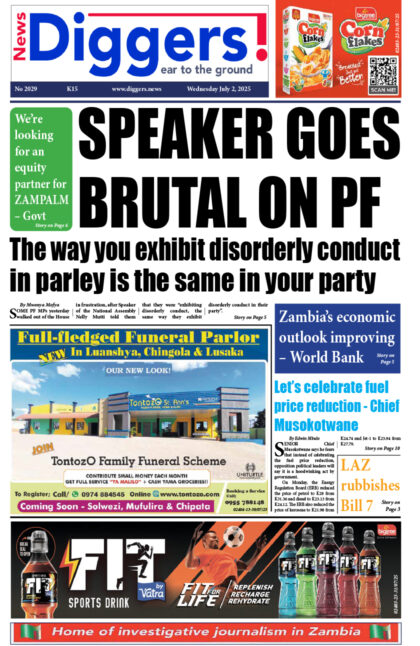The Engineering Institution of Zambia (EIZ) says the Alick Nkhata flyover bridge should be treated as a construction site until all safety measures around it are put in place as it has not been completed and handed over.
And the EIZ says the bridge, which was officially opened on December 3, 2019 by Lusaka Province minister Bowman Lusambo, is not a death trap and will be safer once proposed safety enhancements by the Institution are put in place
Speaking during a media briefing, Monday, EIZ president Engindeer Eugene Haazele noted that the contractor is currently on site, meaning that the project has not yet been handed over.
“In construction, we have got contracts and procedures. It works like this; there is what we call substantial completion, when a project is erected and all the markings are done and then the contractor hands over the site back to the client and all he does is observe if there are any defects showing up but to make your life easier. I would say this to you, if you go to that site today, you will find the contractor. The contractor is there and the signs are not put up, the bridge has not been handed over that why the contractor is on site. When he hands over he is going to vacate so it’s not been handed over. I am calling it a site because it is not a project that has been completed and handed over,” Eng Haazele said.
He added that the institute had carried out a safety audit that resolved that there are no visible signs of distress on the bridge structure.
“I will give you a run down of the certification process. On a project like that, there will be a structural engineer, now that structural engineer is licensed to do that work by EIZ and is licensed on the basis of competence to undertake the work so yes, they are certified. It is not a death trap, we need to be very clear there… Yes we have looked at the structure, the approach we took was by way of doing a safety audit and we looked at the safety concerns. These measures that we have recommended are aimed at enhancing safety, so I will repeat myself, it’s not a death trap. There are no visible signs of any distress on the bridge structure, the structural integrity of the bridge is not in question,” Eng Haazele added.
He explained that the EIZ is a regulator and does not take part in the actual projects but plays a regulatory role and only comes up when a complaint is made to protect the public.
“The project has the developer, which is the owner of the project and he hires a professional, it could be an architect, quantity surveyor and engineers. He doesn’t hire EIZ, we are regulators. The reason we got involved was because there was a complaint. Now I don’t how many times I have said this, over and over and over, a professional or is it a regulator is not a player. When you see these development projects happening around the country, we are not players, we are not part of the implementation team, we are regulators, and we are referees. Referees don’t take penalties, they regulate. So we keep getting these questions like ‘where was EIZ when that bridge collapsed?’ We are not players, we come in when there is a complaint to protect the public. The people that are players are the people that we certify to do this work. So we didn’t come in late, we came in at the right time, there was a complaint and we moved in, we could not have gotten there any earlier, we are not part of the project set up, that’s the bottom line,” Haazele added.
Meanwhile, the Institute has noted that the developers insisted on having the flyover bridge as an architectural feature to add aesthetic value and improved pedestrian safety despite space limitations at the site.
“It is noted that the site is highly constrained and space is at a premium. Despite the space limitations, the project owners preferred to have the structure, implying that omission of the bridge was not an option. The project owners preferred that mitigating measures against lack of space be adopted to ensure the structure is built and the anticipated benefits are realized. These are improved pedestrian safety and enhanced aesthetics,” said Eng Haazele.
“Some of the proposed mitigations to enhance safety of the bridge include limiting the approach speed to 40KM per hour and there should be strictly no overtaking, the use of the structure be restricted so that no heavy goods or commercial vehicles with…weight in excess of four tonnes and a carrying capacity exceeding three tonnes should not be allowed over the structure and this should be sign-posted… reconfiguration of the entry arm into the south roundabout; the area around the bridge structure, inclusive of the approaches into the two roundabouts must be well lit to enhance safety, solar powered street lighting with adequate illumination are recommended and to have speed calming measures to enhance the safety of pedestrians as they currently have to walk across the lanes at the bottom of the structure.”




















One Response
I hope that Eng. Haazele has been misquoted! If not, I would like to advise him to drive over the bridge and feel the nasty sensation of weightlessness we feel when descending, even at low speed. If that’s ok with you then you should resign from EIZ for defending rubbish and misrepresenting Engineers.